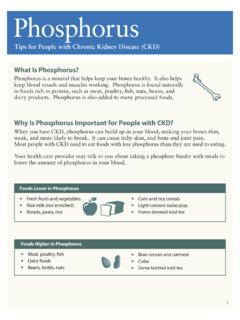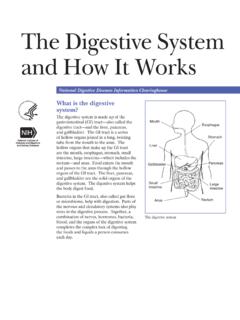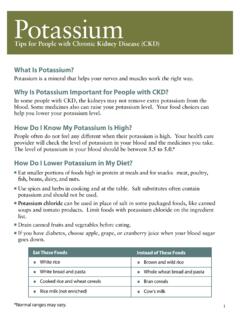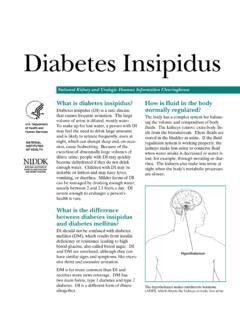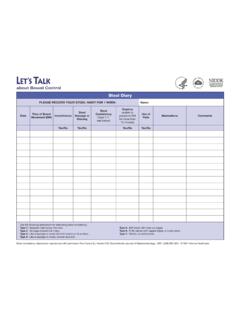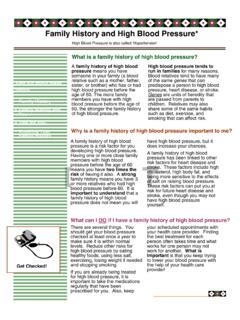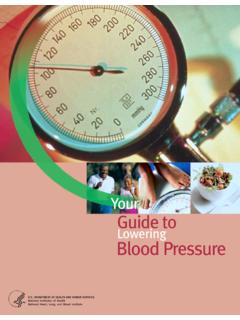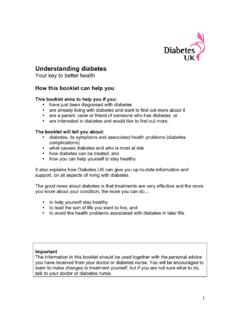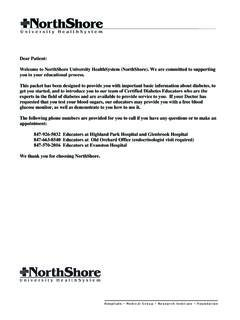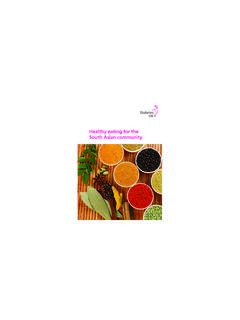Transcription of Your Guide to Diabetes - National Institute of Diabetes ...
1 your Guide to Diabetes :Type 1 and Type 2 National Diabetes Information ClearinghouseYour Guide to Diabetes :Type 1 and Type 2 ContentsLearn about Diabetes .. 1 What is Diabetes ? .. 2 What is prediabetes?.. 3 What are the signs and symptoms of Diabetes ? .. 4 What kind of Diabetes do you have? .. 5 Why do you need to take care of your Diabetes ? .. 7 Who is part of your health care team? .. 8 Take Care of your Diabetes Each Day .. 10 Follow your Healthy Eating Plan .. 10Be Physically Active .. 12 Take your Medicines as Prescribed .. 16 Monitor your Diabetes .
2 21 Keep Daily Records .. 25 Learn about high and Low blood Glucose Levels .. 26 Prevent Diabetes Problems .. 33 Take Care of your Diabetes during Special Times or Events .. 36 When You re Sick .. 36 When You re at School or Work .. 39 When You re Away from Home .. 41 When You re Flying on a Plane .. 42 When an Emergency or a Natural Disaster Happens .. 45If You re a Woman and Planning a Pregnancy .. 46 your Diabetes Care Records .. 48 Points to Remember .. 56 Hope through Research .. 61 Pronunciation Guide .. 63 For More Information.
3 65 Acknowledgments .. 661 Learn about DiabetesYou can learn how to take care of your Diabetes and prevent some of the serious problems Diabetes can cause. The more you know, the better you can manage your this booklet with your family and friends so they will understand more about Diabetes . Also make sure to ask your health care team any questions you might have. You can learn how to take care of your is Diabetes ? Diabetes is when your blood glucose*, also called blood sugar, is too high . blood glucose is the main type of sugar found in your blood and your main source of energy.
4 Glucose comes from the food you eat and is also made in your liver and muscles. your blood carries glucose to all of your body s cells to use for energy. your pancreas an organ, located between your stomach and spine, that helps with digestion releases a hormone it makes, called insulin, into your blood . Insulin helps your blood carry glucose to all your body s cells. Sometimes your body doesn t make enough insulin or the insulin doesn t work the way it should. Glucose then stays in your blood and doesn t reach your cells. your blood glucose levels get too high and can cause Diabetes or time, having too much glucose in your blood can cause health problems.
5 *See the Pronunciation Guide for tips on how to say the words in bold is prediabetes?Prediabetes is when the amount of glucose in your blood is above normal yet not high enough to be called Diabetes . With prediabetes, your chances of getting type 2 Diabetes , heart disease, and stroke are higher. With some weight loss and moderate physical activity, you can delay or prevent type 2 Diabetes . You can even return to normal glucose levels, possibly without taking any medicines. Caution: Take steps to prevent type 2 Diabetes are the signs and symptoms of Diabetes ?
6 The signs and symptoms of Diabetes are being very thirsty urinating often feeling very hungry feeling very tired losing weight without trying sores that heal slowly dry, itchy skin feelings of pins and needles in your feet losing feeling in your feet blurry eyesightSome people with Diabetes don t have any of these signs or symptoms. The only way to know if you have Diabetes is to have your doctor do a blood kind of Diabetes do you have? The three main types of Diabetes are type 1, type 2, and gestational Diabetes . People can develop Diabetes at any age.
7 Both women and men can develop Diabetes . Type 1 DiabetesType 1 Diabetes , which used to be called juvenile Diabetes , develops most often in young people; however, type 1 Diabetes can also develop in adults. In type 1 Diabetes , your body no longer makes insulin or enough insulin because the body s immune system, which normally protects you from infection by getting rid of bacteria, viruses, and other harmful substances, has attacked and destroyed the cells that make insulin. Treatment for type 1 Diabetes includes taking shots, also called injections, of insulin.
8 Sometimes taking medicines by mouth. making healthy food choices. being physically active. controlling your blood pressure levels. blood pressure is the force of blood flow inside your blood vessels. controlling your cholesterol levels. cholesterol is a type of fat in your body s cells, in your blood , and in many foods. 6 Type 2 DiabetesType 2 Diabetes , which used to be called adult-onset Diabetes , can affect people at any age, even children. However, type 2 Diabetes develops most often in middle-aged and older people.
9 People who are overweight and inactive are also more likely to develop type 2 2 Diabetes usually begins with insulin resistance a condition that occurs when fat, muscle, and liver cells do not use insulin to carry glucose into the body s cells to use for energy. As a result, the body needs more insulin to help glucose enter cells. At first, the pancreas keeps up with the added demand by making more insulin. Over time, the pancreas doesn t make enough insulin when blood sugar levels increase, such as after meals. If your pancreas can no longer make enough insulin, you will need to treat your type 2 Diabetes .
10 Treatment for type 2 Diabetes includes using Diabetes medicines making healthy food choices being physically active controlling your blood pressure levels controlling your cholesterol levels7 Gestational Diabetes Gestational Diabetes can develop when a woman is pregnant. Pregnant women make hormones that can lead to insulin resistance. All women have insulin resistance late in their pregnancy. If the pancreas doesn t make enough insulin during pregnancy, a woman develops gestational or obese women have a higher chance of gestational Diabetes .
